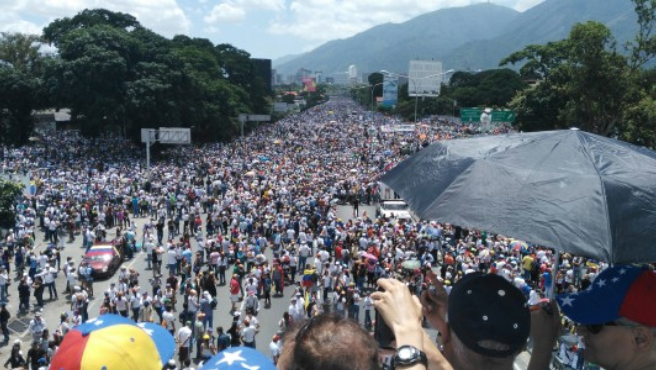Photo from pt. Los Ruices at about 1:15 before concentration actually reached its peak.
Yesterday I went to the opposition demonstration-turned-march, talked to people, took photos and marched as far as I could before it was clear that violent clashes were going to start. The photos I am posting here are all mine. There are better pics on the web, but I will restrict this to what’s on my cell phone. I am going to describe what I can about the logic of the event, to help readers to get a feel for it. I am going to end with some critical comments.
These marches start from feeder points such as Santa Monica, Petare and Caurimare, where I started. The concentration in Caurimare was to take place starting at 10 am and then march to Los Ruices. I didn’t arrive until 12:30 pm; by that time there was a steady stream of people walking on the sidewalks down the Blv. del Cafetal. The boulevard was not closed. Cars passing by honked their horns in support. By the top of the hill in the Boulevard de Caurimare, the police were turning cars around and had the street closed off. From there on we could walk down the middle of the street.
Motorcycles were allowed to pass without restriction, which strikes me as a big mistake in terms of security. There is a big problem with crime in these demonstrations as there is little police presence, and as many pickpockets and thieves as one would expect in a crowd without security.

Marchers from Caurimare arriving to Los Ruices.
Most of the protestors were dressed in white, to symbolize pacific intent. However, one of the most striking elements was how the various “muchachos de la resistencia” mixed in with the crowd. They were dressed in everything from gas masks (some homemade), to baseball catcher’s padding to bicycle helmets and skateboard pads, carrying homemade shields, slingshots and gloves to pick up and throw tear gas canisters back at the National Guard and police.
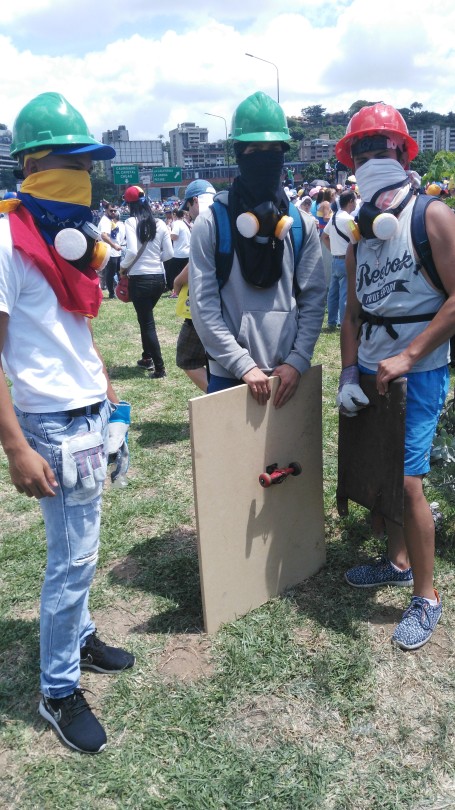
Young men forming part of “la resistencia” with homemade gear. Shield has a skateboard truck and wheels as a handle. They only permit pictures with their faces covered.
They walked around with serious and contemplative looks, frequently applauded by those in the protest. They themselves did not miss the chance to pass around a hat or bucket to collect money. People often stop and ask for photos with them.
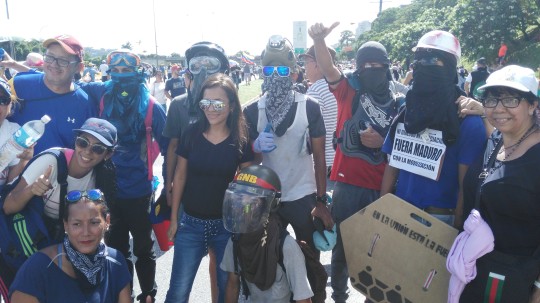
Marchers stop to take a photo with “la resistencia” who in turn ask for contributions of food and money.
The demonstration reached its fullest when varying opposition politicians took turns saying their piece. One sign of how unified the opposition has become is the fact that everyone was roundly applauded. Even when Henrique Capriles was announced he was enthusiastically supported. Three years ago during #lasalida he was frequently booed or given only polite applause. Overall the unity and enthusiasm of this crowd was impressive and different from what I had seen before.
The one thing that broke up the speeches and cheers was a police helicopter that would hover close by, drowning out the speakers. To say it buzzed the crowd would be an exaggeration. But it was clearly there to harass and intimidate.
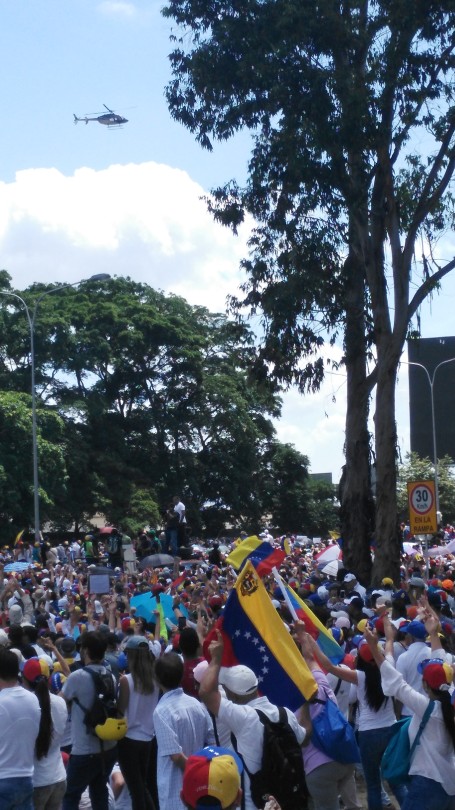
At the end of Henrique Capriles’s speech he announced that they were going to march to the Ministry of interior and Justice and everyone cheered. Slowly the massive crowd began to turn to the west and began walking. However, at that point the young people in “the resistance” began to jog in single file to the front of the march where they would be the “grupos de choque,” the first line of protestors that would clash with the National Guard. People opened up a corridor for them and they were roundly applauded, rendering a feel of gladiators being sent to the frontline to protect the people from the enemy.
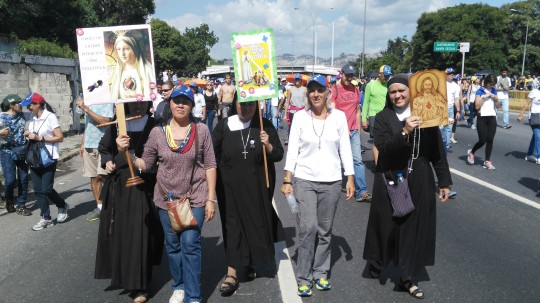
Group of nuns marching.
The walk that I participated in was peaceful as far as I could see with few manifestations of aggression, other than some young men trying to burn a billboard of Maduro.

Young men try to burn down a billboard of Maduro using a long poll with a gasoline-soaked burning rag.
However, I turned around with many other people once I arrived at the Centro Comercial Ciudad Tamanaco and headed back to El Cafetal as it was clear that the protest was going to turn into violent clashes with the National Guard. I am happy to let my journalist friends with protective gear cover that part of the protests.
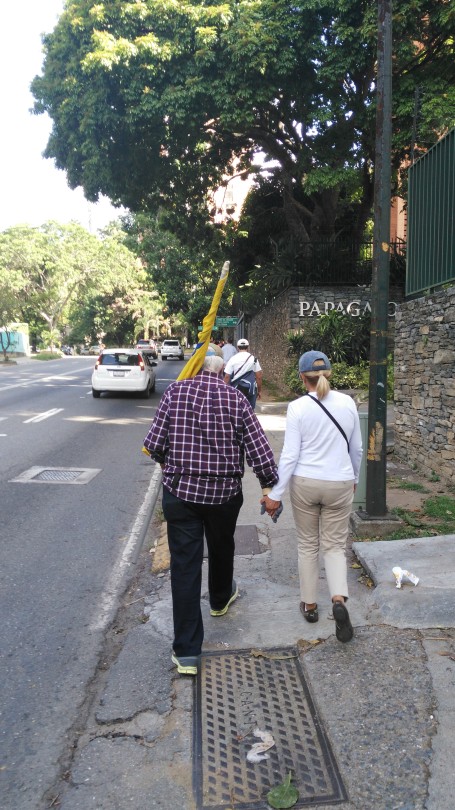
Elderly couple heads back to middle class neighborhood of El Cafetal.
Critical Comments
Overall I was impressed by the size of this march, the unity and the resolve of participants. I had estimated 100-200k people (I think of these things in terms of football stadiums. I know what 80k people looks like. This looked like about 2 football stadiums of people). Some media are saying 200k, it is hard to know since it extended so far in each direction on the highway. People seem to have a clear sense that this is the point of no return. Indeed, if the Maduro government is allowed to rewrite the constitution, it could succeed in consolidating a dictatorship for generations to come.
One persisting weakness in opposition mobilization is that this crowd was remarkably middle class. One of the reasons that I chose to part from Caurimare is that presumably this would be closest to the areas where the Petare concentration would arrive, and I had thought this class segmentation had begun to change. Of course it is hard to actually determine people’s social class without doing a representative sample on income, education and residence. But what was immediately clear was how different the people selling water, beer and snow cones looked from those attending the demonstration in terms of dress and skin color. The opposition was able to get the votes of the popular classes in December 2015, but does not yet seem to be able to mobilize them for their street events.
This march, like most over the past fifty days, ended with violent clashes. What kind of attitude should we take towards this violence? Here are some comments pointing in various different directions and not summing to any sort of neat conclusion.
When you take a democratic population, immiserate them and take away their right to hold their leaders accountable and choose who they want to govern them, violence should be expected. In most times and most places in human history, the question of “whose in charge” has been decided through violence. Only relatively recently, and never universally, has this question been decided through electoral mechanisms. When you withdraw these mechanisms, you should expect violence to reemerge as the preeminent mechanism of social control, sorting and hierarchization. The violence that has occurred so far is relatively small scale. It is what has been called by some scholars “uncivil society,” i.e. uncivilized actions by a population subject to oppressive rule. This type of violence was also common in fighting against dictatorships in Southern Cone countries. And we should not be surprise that if this situation continues on, things could get much worse.
That said, it is disturbing that opposition politicians do not do more to stop the violence. Henrique Capriles called on the marchers to head to the Minister of Interior and Justice knowing that it would be repressed by the Guardia Nacional before arriving. That part seems entirely legitimate to me. These marches are repressed because of unconstitutional restrictions of the freedom of expression–the government prohibits them from entering the Municipal Liberator (downtown). And this restriction should not stop the protest movement from trying time and again. Doing so is an effective way to demonstrate to all, the authoritarianism of the Maduro Government.
Capriles emphasized that he would be at the head of the march. That is the right attitude. If a particular politician is calling for people to risk their safety, he or she needs to be in the frontline, bearing that risk as well.
What was strikingly absent was a call for non-violence. Unless it was drown out by the police helicopters, I did not hear any call for violence to be avoided. Instead there was an implicit approval of the “muchachos de la resistance” heading up front with their makeshift armor and weapons, to do battle with the security forces. This was accompanied by overt approval and heroe’s applause by the protestors. It is hard to overestimate the impact of that type of praise on young people.
It is important to pause and think about the logic of this kind of protest. When asked, those who throw rocks and molotov and shield themselves from tear gas canisters shot as projectiles and rubber bullets say they do what they do “para pasar,” to pass the police line. But even if they were successful, what would that accomplish? Even if they got to, say, the Ministry of Interior and Justice, they would find closed doors and ears. This should be obvious.
Rather, the violence protestors are subject to works in the opposition’s favor as it creates spectacular national and international coverage, shows this government to be undemocratic and repressive, and galvanizes national and international opinion against it. Put differently, the only way these “muchachos de la resistencia” contribute to the opposition’s cause is by becoming victims of government violence. There is no other manifest function of their violent clashes with security forces. Of course human beings often make such sacrifices for the greater good. However, it is not clear to me that these young people understand the logic of what they are doing, while I suspect that many professional politicians do.
Furthermore, I think there are clear alternatives. In his speech Henrique Capriles could have clearly stated that there should not be violence when confronted by security officials. He could have gone even further and made a call to the young people dressed like gladiators that they were not helping the cause and that confronting the National Guard is not necessary. Instead he and other politicians could call for scrupulously peaceful protest that walks directly to the police lines and faces them down. There would undoubtedly be victims. But there are anyway, even with shields and hockey masks. The optics might be less spectacular, but they probably would be even more effective.
I am definitely not suggesting that the opposition should stop resisting. I think they need to continue street mobilizations to keep pressure on the government to return to democracy, and to maintain the attention of the international community. But they need to do so being honest with all who are involved, especially young people with their whole lives ahead of them and who end up getting hurt. And of course they also hurt people. A lot of damage can be done to another human being with a slingshot, molotov cocktail or well placed rock. Opposition politicians will never be able to control all of the violence. People are outraged and will act on their own. But they could do much, much more to reduce it and to get their supporters to stop treating violent protestors as heroes.
Governments and human rights groups that make declarations regarding the situation in Venezuela need to first and foremost demand that the government restore the people’s democratic guarantees, including not only the right to vote but the right to peaceful protest, policed following international standards.
But they also need to demand that opposition leaders be clear in defining their movement as non-violent, and intolerant of violent protest. I am not suggesting that the international community needs to exercise balance in their critique or suggest there is a moral equivalence between the two sides–in this battle there is no balance, one side has the institutions of government, armed forces and state oil company and is responsible for the conflict. But both sides need to be called on to exercise responsible leadership to protect average people even in times of conflict.
[Addition: I wrote this post before watching this savage video. This clearly happened in the context of the opposition mobilization yesterday–the street is closed off and several of the kids are hooded or have their faces covered like the “resistencia” did. It only underlines the dangers of leaders permitting contexts and practices of decentralized violence. Whatever this kid was doing (my guess is that he was robbing someone, how would anybody know if he was an “infiltrator?”), nothing justifies this kind of violence. The silence of the MUD on this so far speaks loudly to average Venezuelans.]

